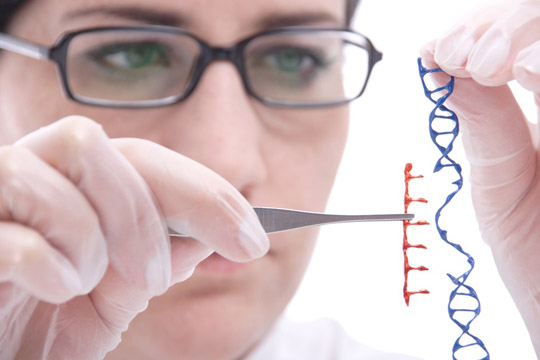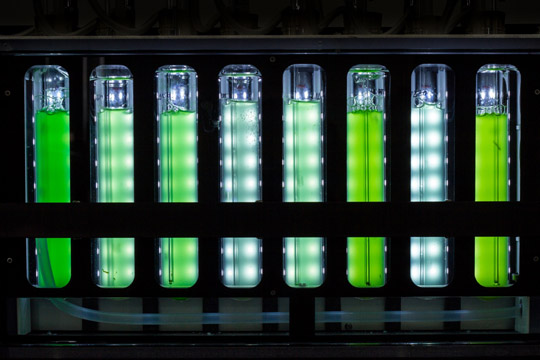Subcontracting Genetic Scissors
Freiburg, Jun 19, 2018
CRISPR/Cas systems are so-called genetic scissors that can be used to change, study, and optimize the genetic material of any organism – from plants and animals to humans. A working group of geneticists and bioinformatics specialists from the University of Freiburg is currently researching what possibilities this procedure offers using cyanobacteria as an example. They recently made a surprising discovery: In the cyanobacterial model organism, the CRISPR/Cas systems borrow industrious enzymes as tools for their work.
 CRISPR/Cas can be used to create a double-strand break anywhere in the DNA sequence through cutting. After a break, the cell’s natural repair mechanism takes care of the problem right away. However, if specially altered DNA templates are available, these sections can be integrated into the DNA as well.
CRISPR/Cas can be used to create a double-strand break anywhere in the DNA sequence through cutting. After a break, the cell’s natural repair mechanism takes care of the problem right away. However, if specially altered DNA templates are available, these sections can be integrated into the DNA as well.
Photo: Gernot Krautberger/Fotolia
Cyanobacteria have populated the earth for more than three billion years. They can usually be found where there is light: in desert regions, rivers, lakes, on the outer walls of buildings, and in aquariums. They are also little marvels. “They are the only microorganism that can produce oxygen through photosynthesis due to their chlorophyll,” said the molecular biologist Prof. Dr. Wolfgang Hess from the University of Freiburg. This makes them especially suitable as a model organism. “However, these bacteria can also contract a virus and become ill,” Hess added. Hess is currently collaborating with the PhD student Juliane Behler to study the possibilities offered by the CRISPR/Cas system when used on cyanobacteria. “CRISPR/Cas systems are extremely diverse and therefore provide the best tools for biologists to influence the regulation of biological processes,” he said.
A cyanobacterium is able to recognize a virus that it has contracted in the past and to destroy it when the next infection comes along. It harvests the viral DNA, so to say, and firmly integrates it into its own DNA. There are regularly occurring, repeated sequences in the CRISPR’s memory, in between which the small, cut-up DNA fragments of the virus are put away like books in a bookshelf. The cell then produces RNA counterparts to the DNA of the virus that bind with the Cas proteins to create controller and cutting units. These teams patrol the cell and identify the pathogens attacking it based on its archive of DNA. Once identified, the Cas scissors begin to cut up the virus’s DNA. This clever system is able to determine whether the pathogen is dangerous (meaning it will be cut up) or not (meaning it will be left alone).
Genome Editing Made Easy
CRISPR/Cas can be used to create a double-strand break anywhere in the DNA sequence through cutting. After a break, the cell’s natural repair mechanism takes care of the problem right away, and often everything returns to normal. However, if specially altered DNA templates are available, these sections can be integrated into the DNA as well. The result is similar to a mutation, only much more controlled. Natural mutations can occur, for example, when UV rays cause many DNA breaks. With the CRISPR/Cas method, however, the breaks occur in a selected area with a precision that was previously unobtainable. Although editing genome sequences has its origin in bacteria, it can also be performed in all cells and organisms in principle, including humans.
 The cyanobacteria inside the photobioreactor are able to identify a contracted virus and destroy it when the next infection strikes. The team of researchers from the University of Freiburg are using cyanobacteria as a model organism.
The cyanobacteria inside the photobioreactor are able to identify a contracted virus and destroy it when the next infection strikes. The team of researchers from the University of Freiburg are using cyanobacteria as a model organism.
Photo: Dominik Kopp
The modification of DNA is only one of its many aspects, however. “CRISPR/Cas is one of the most diverse systems used in biology that we know of,” said Hess. The research team used a representative of the cyanobacteria family, synechocystis, as a model for their research. These bacteria, which develop into dark green or blue-green cultures in Erlenmeyer flasks and photobioreactors, have an especially high cell density and a high yield of substances that are created through photosynthesis.
An Enzyme Is Unfaithful
Synechocystis always has a surprise up its sleeve. While applying one of the CRISPR systems to the model organism, the researchers discovered that it was functioning with an enzyme that didn’t belong: RNase E. The team then used methods from bioinformatics to determine that the enzyme that CRISPR normally works with was no longer present. “Instead, the CRISPR system recruited this new RNase type enzyme for this purpose,” said Hess. It has been known for some time that several genes that are more or less part of an organism’s basic hardware have maintained the same structure and function for billions of years. RNase E is a fixed component of cyanobacteria and has predetermined functions. “It is a very old, established key enzyme, and its function in gene regulation has been well documented in research,” said Hess. When the correct enzyme was missing, the CRISPR used RNase, which in cyanobacteria is actually responsible for breaking down surplus RNA, among other things. The enzyme thus behaved very untypically: In its new function, it cut out sections of the CRISPR RNA that are responsible for identifying viruses and fuse with the Cas protein to create a defense complex.
The change in function of RNase E gave the researchers a new idea. Their next step is to let the bacteria produce large amounts of substances in photobioreactors: for example, ethanol, biofuel, or food supplements in the form of carotenoids. Such producer strains are particularly vulnerable to virus infections, but with these new findings, the CRISPR activities in the cell could be better controlled. Hess said that this would increase the chances of their immune system remaining stable and being able to spring into action when needed. “Until now, there are no successful systems anywhere in the world that can make strains resistant to viruses,” said Hess. Perhaps the researchers at the University of Freiburg will be the first.
Stephanie Heyl

